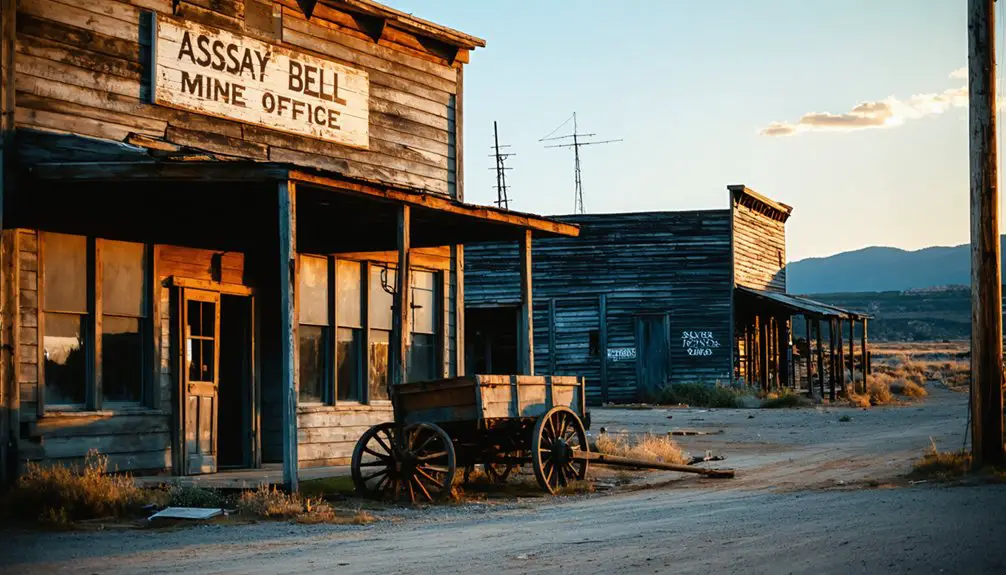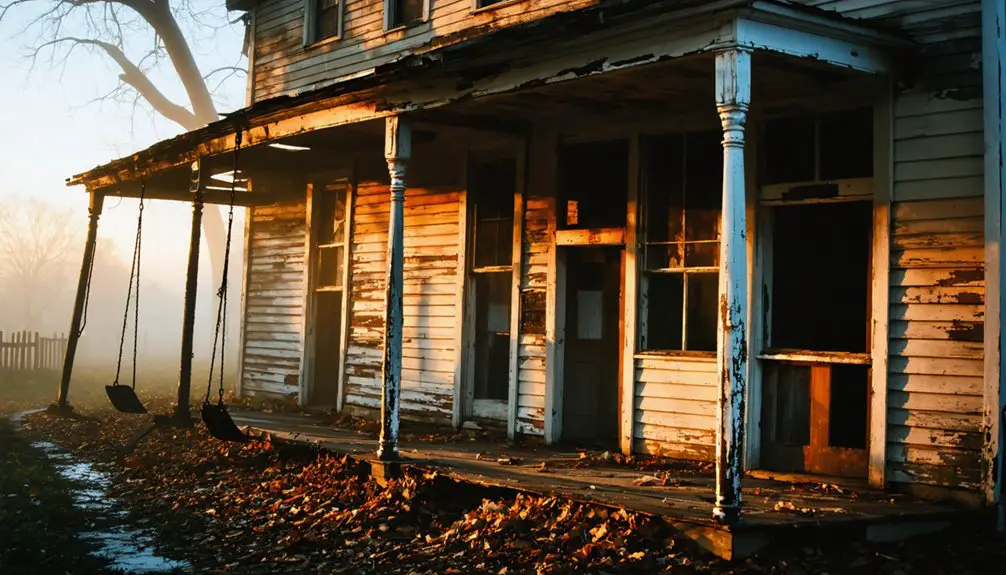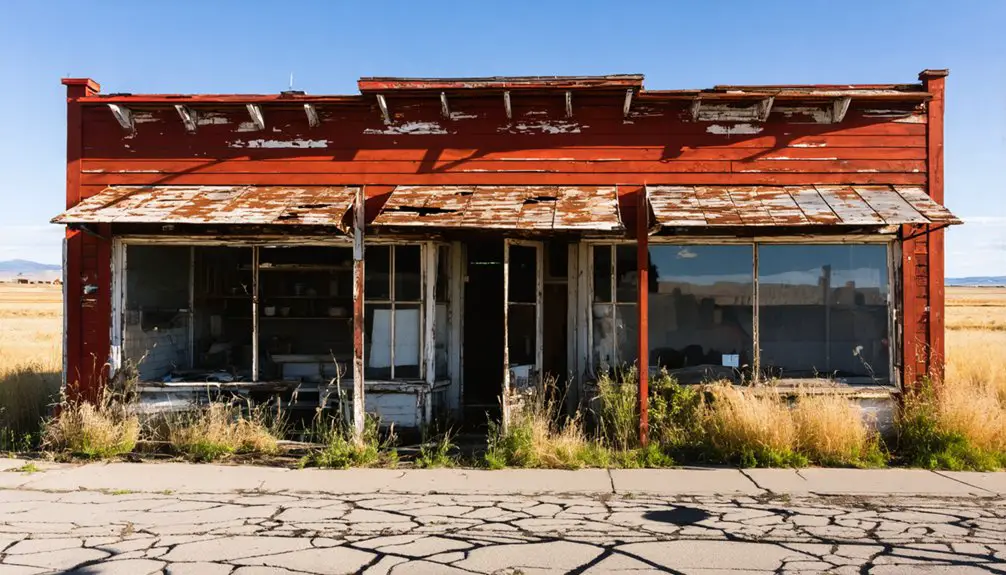You’ll find Loomis nestled in Washington’s Okanogan County, where it began as a modest trading post before booming into a vibrant silver mining town in the 1890s. The town’s three-block Main Street once buzzed with eight saloons and dance halls, serving as the social hub for miners and their families. While the silver crash of 1893 triggered its decline, Loomis’s mining remnants and ghostly tales still echo through its quiet country roads.
Key Takeaways
- Loomis was a prosperous silver mining boomtown in Okanogan County, Washington, featuring eight saloons and entertainment venues during its 1890s peak.
- The silver market crash of 1893 devastated the local economy, leading to mine closures and eventual transformation into a ghost town.
- Historic remnants include ore car tracks, miners’ cabins, and deteriorating main street buildings that showcase the town’s mining heritage.
- The town’s paranormal folklore centers around the notorious Loomis Gang and matriarch Rhoda Loomis, attracting ghost town tourism.
- Today, Loomis preserves 25,000 acres for conservation while maintaining vestiges of its mining past through guided historical tours.
From Loomiston to Mining Boomtown
While many frontier settlements emerged from humble beginnings, Loomiston’s transformation from a modest trading post to a vibrant mining boomtown exemplifies the rapid development that characterized America’s western expansion.
Pioneer merchant J.A. Loomis established the first store, creating a foothold for cattle ranching and local trade in Okanogan County, Washington. The town, located just 20 minutes south of Nighthawk, grew steadily with its strategic position. You’ll find the town’s turning point came in 1886 when the opening of the Colville Indian Reservation released a flood of prospectors into the area.
By 1891, the bustling main street featured eight bustling saloons and entertainment venues that catered to the growing population of miners.
The Silver Rush Years
Loomis’s prosperity reached dizzying heights during the silver rush of the early 1890s, only to face a devastating market collapse in 1893.
Like a wild mining town rollercoaster, Loomis soared with silver fever before plummeting into economic ruin when the market crashed.
You’d have found a bustling Loomis economy with eight saloons and two dance halls lining the main street, while mining technology advanced with ore car tracks connecting Ruby Mine to Ruby Mill.
The town’s fortunes rode the volatile silver market’s waves. When prices crashed in 1893, miners abandoned their claims, businesses shuttered, and the population plummeted.
But you couldn’t keep Loomis down – by 1898, silver prices recovered, bringing miners back to work the area’s rich quartz vein deposits.
The population swelled again to over 500 by 1899, though Loomis retained its rough-and-tumble character typical of Okanogan County’s mining camps. The town became known for its free circulation of gold dust as miners often undervalued their findings.
Life on Main Street: Saloons and Dance Halls
If you’d walked down Loomis’s Main Street during its heyday, you’d have found yourself amid a bustling three-block stretch alive with eight saloons and two dance halls.
These establishments served as the heart of the mining community‘s social life, where card players like “Ding Bat” tried their luck and miners gathered to share news and unwind after long days in the mines. The town’s first business was a general store operation, which anchored the growing community.
The dance halls brought a different energy to the street, hosting regular social events that drew both men and women together, creating moments of joy and connection in this otherwise rugged frontier town. One memorable celebration was the town’s Fourth of July festivities, complete with free music and dancing for all residents.
Wild Nightlife Heyday
As miners poured into the bustling frontier town during the 1880s and 1890s, Loomis’s three-block main street transformed into a lively entertainment district with eight saloons and two dance halls.
Similar to the thriving Law and Order Highlands that operated in Old Molson from 1896 to 1972, the saloon culture thrived as miners, settlers, and travelers gathered to drink, gamble, and unwind after grueling days in the mines. You’d likely find the infamous “Ding Bat” at the card tables, his shrill laughter echoing through the raucous establishments. The establishment of the local post office in 1889 marked a significant milestone in the town’s development.
The dance hall traditions offered a different kind of escape, where you could join fellow townsfolk for regular dances and celebrations.
Characters like “Peg Leg Negro Henry,” a beloved local cook, were fixtures in this vibrant social scene. Together, these venues created the wild nightlife that defined Loomis during its mining boom years.
Mining Town Social Scene
The bustling three-block stretch of Main Street formed the beating heart of Loomis during its mining heyday, hosting a diverse mix of social venues that served the town’s 500 residents.
After long days in the mines, you’d find comfort in the town’s vibrant saloon culture, where eight drinking establishments offered places to unwind, gamble, and share news with fellow miners.
Beyond the saloons, community gatherings flourished in these key spaces:
- Two dance halls where you’d join miners’ balls and celebrate local traditions
- A movie theater and brewery for entertainment beyond the usual tavern scene
- Essential services like the bank, law office, churches, and boarding houses
This social infrastructure created a tight-knit community where both work-weary miners and permanent residents found their place in frontier society. The town’s evolution from a J.A. Loomis trading post helped establish its reputation as a thriving social hub in the region.
Notable Characters and Local Legends
Through its colorful history, Loomis attracted an eclectic mix of characters who left lasting impressions on the town’s folklore. Among the notable figures, you’ll find J.A. and J.H. Loomis, pioneering merchants who gave the town its name.
From humble merchants to colorful characters, Loomis drew an array of memorable pioneers who shaped its unique identity.
The friendly Peg Leg Negro Henry became a beloved local fixture, while the boisterous gambler known as Ding Bat filled saloons with his distinctive laughter.
Perhaps most mysterious was Frank, the hermit trapper whose suspicious death in the 1930s sparked endless speculation. Historical records show the gang was notorious for their expertise in horse theft and counterfeiting.
Local legends also tell of supernatural occurrences, particularly ghost sightings connected to the infamous Wash Loomis and his gang. Their violent legacy supposedly lives on through cursed farmland and haunted buildings, where visitors claim to encounter vengeful spirits.
These tales, along with the town’s eight saloons and two dance halls, paint a vivid picture of Loomis’s wild frontier days.
The Great Silver Crash of 1893

If you’d lived in Loomis during 1893, you’d have witnessed the devastating impact of silver’s price collapse from 83 cents to 62 cents per ounce, which forced many local mines to shut down or slash wages.
The crisis hit the mining community particularly hard, as unemployed miners and their families struggled to survive after the Sherman Silver Purchase Act’s repeal triggered an industry-wide collapse. Foreign investors withdrew from the region, further deepening the economic catastrophe.
Your neighbors would have faced stark choices as the town’s economic foundation crumbled, with many forced to abandon their homes and seek opportunities elsewhere, marking the beginning of Loomis’s decline.
Mining Industry Collapse
When silver prices plummeted from 83 to 62 cents per ounce in 1893, Loomis’s mining industry faced devastating consequences.
You’d have witnessed the rapid mining decline as operations shut down across the region, leaving miners and their families with few options for economic recovery.
The collapse hit the community with three major blows:
- Mining companies slashed wages while easily replacing any workers who dared protest
- Supporting businesses like smelters and local services quickly folded
- Mass unemployment forced residents to abandon their homes and seek work elsewhere
The town’s lifeblood drained away as the mining industry contracted.
Without federal aid or alternative industries to absorb the displaced workers, Loomis’s transformation into a ghost town accelerated, mirroring the fate of countless other Western mining communities.
Devastating Economic Impact
The devastating crash of 1893 sent shockwaves far beyond Loomis’s silver mines, plunging the entire nation into financial chaos. As silver prices plummeted from 83 to 62 cents an ounce, you’d have witnessed the catastrophic collapse of over 500 banks nationwide and the failure of 15,000 businesses across America.
The government’s economic policies, including the repeal of the Sherman Silver Act, only worsened the crisis.
In communities like Loomis, you’d have seen firsthand how unemployment soared and families struggled to survive. While larger cities established soup kitchens and relief programs like Detroit’s “Potato Patch Plan,” smaller mining towns had to rely on community resilience.
Without federal deposit insurance, many residents lost their life savings as local banks failed, forever changing the town’s economic foundation.
Remnants of Mining Infrastructure
Mining infrastructure scattered across Loomis and its surrounding hills tells a compelling story of the area’s industrial past. As you explore these historical artifacts today, you’ll discover evidence of innovative mining techniques that once drove this bustling community.
From the surviving ore car tracks connecting Ruby Mine to its mill site, to the visible ruins of processing facilities, these remnants paint a picture of determination and ingenuity.
Key features you can still find include:
- Original miners’ cabins near Ruby Mine
- Millfeed ore bin ruins from 1937 on Ruby Hill
- Extensive waste rock dumps containing roughly 2,600 cubic yards of material
The most striking evidence remains in the cramped underground stopes where miners once worked in spaces as tight as 3.5 feet high, using compressed air drills to extract precious metals from narrow veins.
Ghost Stories and the Loomis Gang

Despite their notorious reign of terror in Central New York, the Loomis Gang’s legacy lives on through chilling supernatural tales that still captivate locals today.
You’ll hear whispers of Wash Loomis’s ghost, the most prominent of the Loomis legends, haunting the territories where his criminal empire once flourished. Ghost sightings often trace back to the gang’s violent history, with reports of otherworldly encounters linked to their murders, arsons, and ruthless intimidation tactics.
The dark reputation of Rhoda Loomis, the feared matriarch who wasn’t above murder to control her sons’ lives, adds another layer to these haunting tales. Local folklore suggests that those who dared stand against the gang’s criminal activities often faced mysterious misfortunes, their stories becoming part of the region’s supernatural fabric.
The Sinlahekin Valley’s Mining Heritage
When “Okanogan” Smith first discovered mineral deposits along the Similkameen River, he unknowingly sparked a transformative era for the Sinlahekin Valley‘s future.
The valley’s geological formations, rich with glacial drift and pre-Jurassic biotite gneiss, created perfect conditions for mineral exploration that would define the region’s destiny.
As prospectors flooded the area after 1896, they discovered:
- Rich silver veins averaging 6 feet thick, dipping 70° to 80° eastward
- High-grade ore shoots yielding 50-150 ounces of silver per ton
- Complex underground networks spanning 4,500 feet of tunnels and shafts
You can still trace this mining heritage in the remnants of the extensive underground workings, where ambitious miners once extracted valuable ores from the Fourth of July vein and other claims throughout Mineral Hill.
Exploring Modern-Day Loomis

If you’re visiting Loomis today, you’ll find a quiet country road where turn-of-the-century homes stand alongside scattered remnants of the town’s mining heyday.
You can follow the preserved ore car tracks from Ruby Mine to Ruby Mill, which offer a tangible connection to the area’s prospecting past.
While most original structures have vanished, local efforts have helped maintain surviving buildings and mining relics as important markers of the community’s rich history.
Remaining Historic Buildings Today
A handful of original buildings from Loomis’s mining boom era still stand today, offering glimpses into the town’s prosperous past.
Unlike other Washington ghost towns with active historic preservation efforts, Loomis’s architectural significance lies mainly in its scattered mining remnants and deteriorating structures.
When you explore the site, you’ll find:
- Miners’ cabins near Ruby Mine, now weathered but evidence of the town’s mining heritage
- Visible ore car tracks and Ruby Mill facility remains that trace historic transport routes
- Main street buildings, though mostly roofless and neglected, marking where commerce once thrived
You’re free to wander these ruins, but exercise caution – the structures are unstable, and old mine shafts pose hazards.
The site offers a raw, unfiltered window into the boom-and-bust cycle of Western mining towns.
Old Mining Trail Routes
The historic mining trails around Loomis tell a compelling story of human ingenuity and determination during the area’s mining heyday.
You’ll find evidence of mining logistics in the snow road built during winter 1915-16, which connected Loomis to the Tungsten Mine at 7,200 feet elevation. Along these historic trails, you can discover remnants of camps named Sunny, Windy, Bear Trap, and Bean, where miners once rested during their arduous journeys.
The trail network stretched from Nighthawk’s rail freight point to various mines, including routes through Palmer Mountain and the Ruby Mine.
Today, you can explore these paths in the Loomis NRCA, where trailheads at Disappointment and Cold Springs Campground provide access to these historic routes, now serving hikers and equestrians while preserving the area’s rich mining heritage.
Local Preservation Efforts
While historic mining trails remain as reminders of Loomis’s past, modern preservation efforts have transformed this former boomtown into a protected wilderness sanctuary.
Through remarkable community engagement, a coalition of 70 organizations raised $16.5 million in 1999 to protect 25,000 acres from logging.
The conservation impact of these preservation efforts includes:
- Transfer of land to Loomis Natural Resources Conservation Area status
- Protection of critical wildlife habitat for endangered species like Canada lynx
- Development of sustainable recreation infrastructure while preserving historical mining remnants
You’ll find thoughtfully managed trails, campgrounds, and equestrian facilities that balance public access with conservation.
While most original structures have vanished, you can still discover ore car tracks and miners’ cabins that tell the story of Loomis’s mining heritage.
Preserving a Mining Town’s Legacy
Despite its dramatic decline from a bustling silver mining hub, Loomis’ physical and cultural legacy endures through scattered remnants across Washington’s Okanogan County.
You’ll find tangible connections to the past in the surviving turn-of-the-century homes along old main street, ore car tracks from Ruby Mine, and miners’ cabins dotting the hillsides.
These remnants attract ghost town tourism while telling stories of boom-and-bust cycles that shaped the American West. The town’s cultural heritage lives on through oral histories passed down by descendants and longtime residents, preserving tales of the eight saloons, dance halls, and mining ventures that once defined this frontier community.
Ghost towns like Loomis speak through their ruins, preserving memories of frontier life through stories passed down by local families.
While nature slowly reclaims many historic structures, Loomis stands as a powerful reminder of the region’s mining heritage and pioneering spirit.
Frequently Asked Questions
Are There Any Remaining Descendants of J.A. Loomis Still Living in the Area?
Like pages torn from history’s book, you won’t find confirmed Loomis descendants in the area today. Despite J.A. Loomis’s significant family history there, available records don’t show any relatives remaining.
What Was the Average Daily Wage for Miners During Loomis’ Peak Years?
You’d find miner’s wages averaged $2.75 per day during Loomis’ peak years in the early 1900s, including board and meals – a fair rate in the historical economy of that mining era.
Were There Any Significant Native American Conflicts During Loomis’ Settlement Period?
You’ll find that broken Native American treaties sparked regional conflicts near Loomis during settlement, though no major battles occurred within town limits. Settlement impacts spread violence throughout eastern Washington in the 1850s.
Did Loomis Have Its Own Newspaper During the Boom Years?
You won’t find evidence of a Loomis newspaper during the boom years. While the town had saloons, stores, and a post office, historical records don’t show any established journalism or printing operations.
What Happened to the Original Land Deeds After the Town’s Decline?
You’d find most land ownership records were likely maintained by Okanogan County, though specific deed transfers aren’t documented. Original deeds probably lapsed, consolidated with descendants, or reverted to government control.
References
- https://thecolgatemaroonnews.com/14662/news/the-loomis-gang-and-the-ghost-of-wash-loomis/
- https://okanogancountry.com/ghost-towns
- http://www.ghosttownsusa.com/loomis.htm
- http://www.ghosttownsusa.com/bttales55.htm
- https://okanogancountry.com/poi/nighthawk
- https://www.scenicwa.com/poi/nighthawk-ghost-town
- https://www.youtube.com/watch?v=FVveO9uJBvc
- https://www.historylink.org/file/8810
- http://www.ghosttownsusa.com/bttales15.htm
- https://www.dnr.wa.gov/publications/ger_b64_geol_min_dep_loomis.pdf



